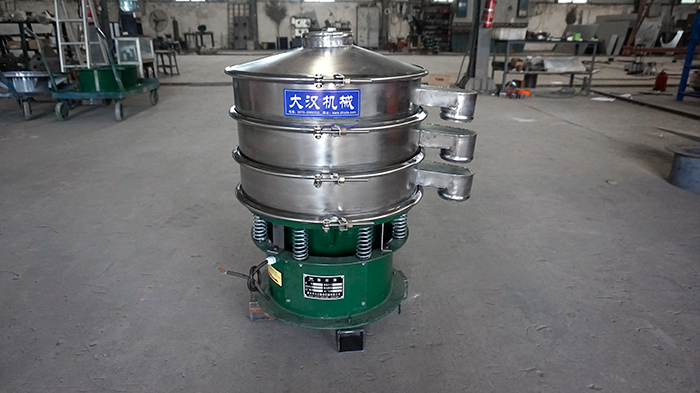
Battery materials vibrating sieve is mainly used to sieve all positive and negative electrode materials of battery materials, such as graphene, lithium cobalt oxide, lithium iron phosphate, etc. The particle size distribution of battery materials is controlled by classifying battery material micropowders with different particle sizes.
Xinxiang Dahan battery materials vibrating sieve adopts an ultrasonic deblinding system, vibrating the grid through ultrasonic frequency, and the vibration frequency is increased from 1450 times per minute to about 36,000 times per minute, which improves the sieving rate of battery materials and prevents materials from being blocked due to screen blockage. , which can solve the problem of blocking the network caused by the characteristics of high fineness, high adsorption type, static electricity, and easy agglomeration of battery materials.
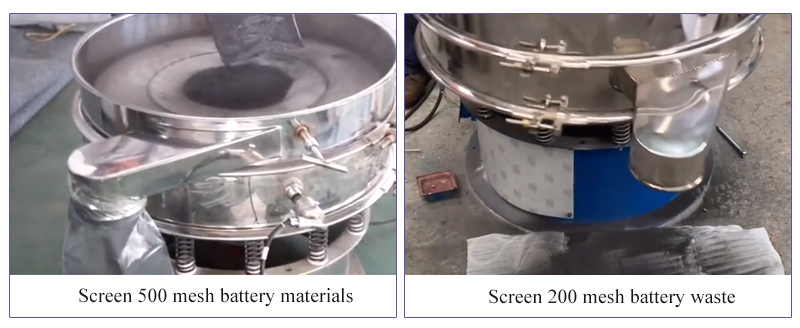
Positive electrode material: lithium cobalt oxide lithium iron phosphate lithium manganate ternary material (lithium nickel cobalt manganate).
Anode materials: carbons (artificial graphite, natural graphite, mesocarbon microspheres), lithium titanate.
In the positive and negative electrode materials of the battery, the materials that do not meet the production requirements need to be separated out and crushed for reuse. However, during the screening process, due to the relatively fine positive and negative electrode materials, static electricity will occur after the materials rub against each other. Problems such as adsorption and agglomeration will greatly reduce the screening accuracy and output, and iron and copper metals will pollute the raw materials, resulting in a reduction in the capacity of lithium batteries. So it is obviously not suitable to use ordinary vibrating sieve at this time. Using battery materials vibrating sieve with ultrasonic deblinding system can sieve on finer meshes (down to 20 microns) without any blocking or blinding of the aperture. It also increases throughput and reduces cleaning times.
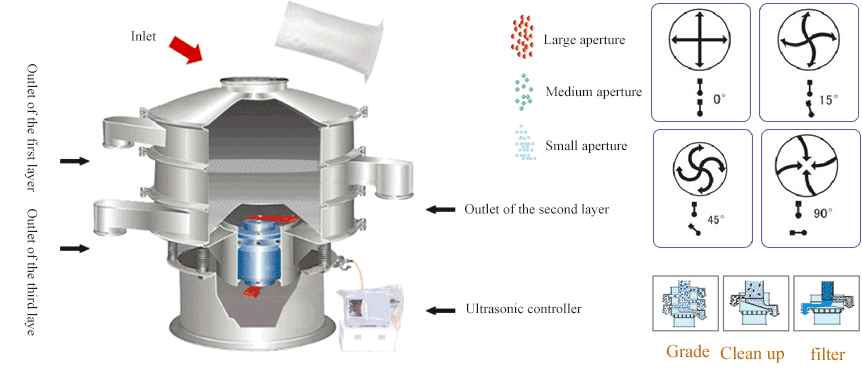
The battery materials vibrating sieve adopts 18KHz mechanical vibration. The organic combination of the ultrasonic controller and the vibrating screen can make the battery materials attach a high frequency and low amplitude ultrasonic vibration wave to the screen of the vibrating sieve. The battery material on the surface of the mesh is always in a suspended state, which inhibits the process of clumping and blocking the mesh, thereby inhibiting the blocking factors such as adhesion, friction, leveling, and wedging, thereby solving the problem of difficult screening of battery materials.
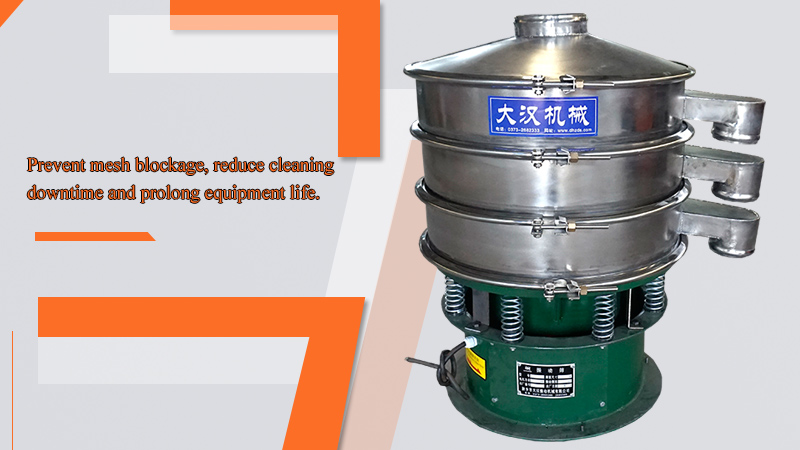
1. The battery material has high adsorption, strong viscosity, static electricity, easy to agglomerate, and low screen penetration rate during screening. The battery materials vibrating sieve of the ultrasonic deblinding system can be added to screen materials on a 20-micron screen. Prevent mesh clogging.
2. The ultrasonic frequency vibrates the mesh, making it easier for the battery material to pass through the mesh, and the system increases the screening capacity by 10 times.
4. Prevent mesh blockage, reduce cleaning downtime and prolong equipment life.
5. Install an iron remover at the feeding port. During the feeding process, the battery material first passes through the iron removal silo, and the magnetic bar in it will absorb the iron filings in the material to realize the removal of the iron filings.
6. Fully sealed setting, the feeding port can be equipped with a vacuum feeder, and the discharge port can be fully sealed by the installation of the silicone soft connection to realize the gap between the discharge port and the receiving bin, which realizes the battery material The airtight screening process from feeding, screening and receiving can effectively prevent the problem of dust escape.
7. Teflon is added inside the equipment to increase the wear resistance and lubricity of the equipment, and avoid heavy metal substances polluting the battery materials.
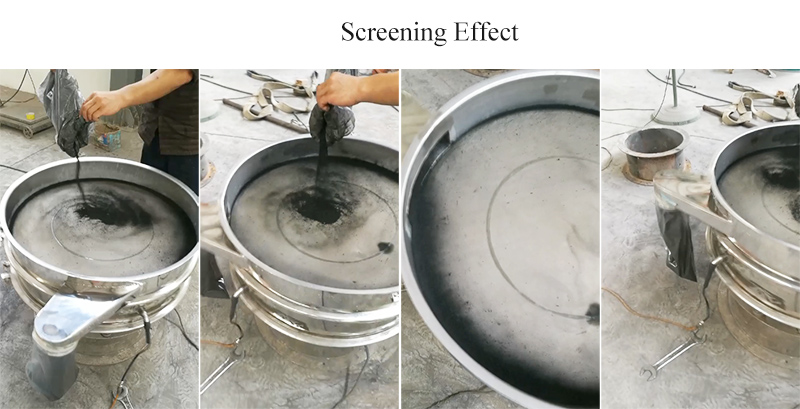
Battery materials vibrating sieve for 325 mesh graphite powder
Screening waste lithium battery materials
| Model |
Screen Diameter (mm) |
Sieving Area (m2) |
Screen Size (mesh) |
Layers |
Power (KW) |
| DHC-400 | 340 | 0.091 | 80-600 | 1~3 | 0.18 |
| DHC-600 | 540 | 0.229 | 0.25 | ||
| DHC-800 | 730 | 0.418 | 0.55 | ||
| DHC-1000 | 900 | 0.636 | 0.75 | ||
| DHC-1200 | 1100 | 0.95 | 1.1 | ||
| DHC-1500 | 1400 | 1.539 | 1.5 | ||
| DHC-1800 | 1700 | 2.269 | 2.2 | ||
| DHC-2000 | 1886 | 2.792 | 2.2 |
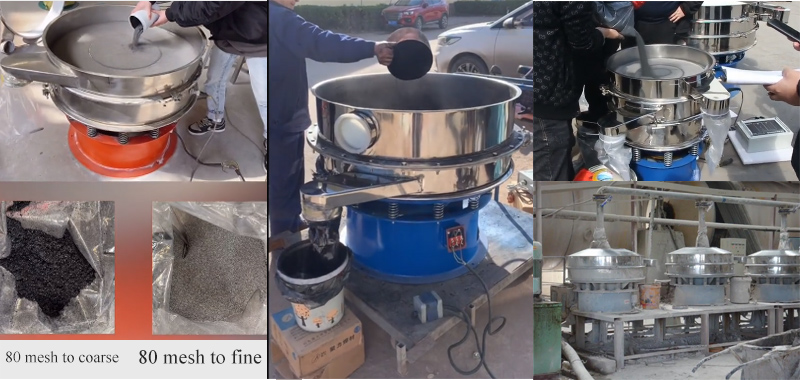
| Raw Material | Proportion | Mesh Siza | Model | Method |
Capacity (kg/hr ) |
| Graphite powder | 1.2 | 16/40/80 | DH-1000-3S | Dry | 1400㎏ |
| Lead powder | 11.34 | 10/80 | DH-1000-2S | 1000㎏ | |
| Tungsten carbide powder | 7.5-9.0 | 20-60 | DH-800-2S | 400㎏ | |
| Gold copper powder | 2 | 100 | DH-800-1S | 70㎏ | |
| Iron powder | 3 | 400 | DH-800-1S | 230㎏ | |
| Aluminum powder | 0.9/1.2 | 80/120 | DH-800-2S | 350㎏ | |
| Electrode powder | 0.95 | 20/200 | DH-1000-2S | 550㎏ | |
| Titanium dioxide | 2.1 | 16 | DH-800-1S | 600㎏ | |
| Manganese dioxide | 2 | 60 | DH-1000-1S | 1550㎏ | |
| Electrolytic copper powder | 1.5/2.4 | 24 | DH-1000-1S | 210㎏ |
Address:China,Yanjin county forest park gate to the west 1000 meters north road.